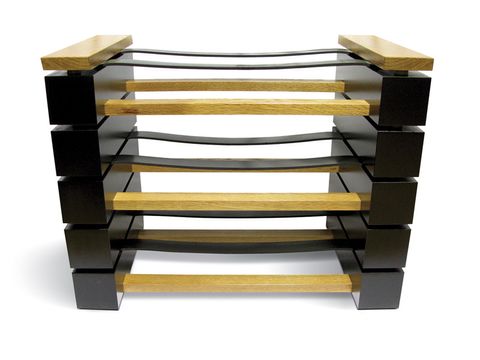TechRadar Verdict
Pros
- +
Gives real isolation across the audio band
Cons
- -
Can convert ultra-low frequency vibration into turntable wow
- -
Bulky
Why you can trust TechRadar
There have been plenty of new designs for equipment supports over the years, the majority of them taking rigidity seriously along with such anti-vibration measures as spikes. A few, though, seek to decouple equipment more thoroughly using sprung or otherwise 'floppy' support systems, with or without damping.
Newcomer Magic Racks has come up with an ingenious way of implementing the floppy approach, using what are basically rubber bands – long strips of neoprene rubber, placed between supports in such a way that they keep equipment clear of the floor or the level underneath, while allowing it to bounce freely.
In the standard configuration, two such strips are used, attached to substantial chunks of MDF (painted black in our review sample, though we understand alternative colours are available to order) which are held apart by two pieces of varnished oak.
Strapping newcomer
The Magic Rack is modular, with a single level consisting of one strap/side assembly plus a pair of spacers (again large chunks of MDF) which fit on the sides with a pair of thick, stubby oak dowels.
A further level can sit on top and when you're done you simply top off the assembly with a pair of decorative oak pieces. The end result is bulky and looks a little odd, but it does support equipment in a way that provides real isolation from the floor.
The straps are adjustable and equipment can be levelled side-to-side simply by sliding it a little to left or right. Items like turntables with an outboard motor can be supported on a slab of something solid: Magic Racks recommends MDF, but we imagine that a piece of stone (marble, maybe, or granite) could do a good job and look stunning with it.
Ideal balance
A little care is needed in dressing cables, to avoid pulling equipment off the ideal balance point, but it would need a really hard tug to unseat any item completely.
The resonant frequency is in the range 5-10Hz, lightly damped by the intrinsic lossiness of the rubber, which means that at all audio frequencies there is a high degree of attenuation of incoming vibration: similarly, there will be very little vibration transmitted between levels of a rack.
But does it work?
Most modern electronic components are not significantly microphonic, but some valve amps and FM tuners show distinct sensitivity to vibration, many CD players seem to have a small degree of microphony and practically all turntables 'read' their support in great detail.
We tried each category of component and were on the whole quite impressed. Certainly we felt that valve amps gave a very good result on the MR1, with bass tighter than ever and stereo imaging noticeably more precise than on a rigid floor-mounted support. We really couldn't find a downside in this case, although for many valve amps you'll need an extra-high spacer to allow for the generous dimensions and heat.
That's magic
With solid-state amps and CD players differences were naturally more subtle. The acid test is the turntable, and here we had mixed results. Basic isolation is very good and the sound clearly benefits.
However, on a suspended floor you can easily run into problems with footfall, and even with more subtle vibration from adjoining rooms or from outside.
The trouble is that the suspension is quite free in a rotational sense, which can easily lead to simple up/down vibration turning into wow and flutter, one of the most audible ills of LP replay. On a solid floor, though, results are excellent.
Follow TechRadar Reviews on Twitter: http://twitter.com/techradarreview

